Dover - Once a Roman lighthouse - later part of the fortress
- Written by Portal Editor
Dover - The approximately 563 km long English Channel continues as an inlet to the Atlantic Ocean towards the North Sea and tapers like a sleeve.
At its narrowest point there is the ferry connection from Calais to Dover, which we had just crossed. The shape of this taper also explains the German name Ärmelkanal (English Channel), possibly also as a translation from the French "La Manche".
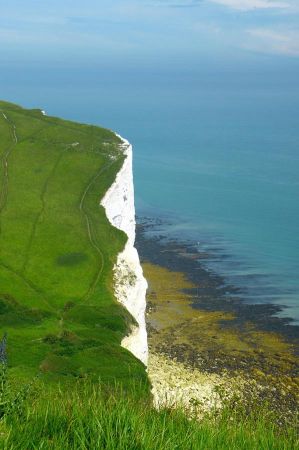 The Romans in antiquity, however, called the sea area Oceanus Britannicus, which is documented in the writings of Claudius Ptolemaeus, among others. This name was used almost throughout the Middle Ages or translated into the respective language. A designation that indicates the English Channel can be found for the first time on an Italian map from 1450 as Canalites Anglie.
The Romans in antiquity, however, called the sea area Oceanus Britannicus, which is documented in the writings of Claudius Ptolemaeus, among others. This name was used almost throughout the Middle Ages or translated into the respective language. A designation that indicates the English Channel can be found for the first time on an Italian map from 1450 as Canalites Anglie.
This designation was also used on the maps of the leading seafaring nation of that period, the Netherlands, in Dutch as Het Engelse Kanaal, which has also been established in Great Britain as “The English Channel” since the 18th century at latest.
English-speaking Northwest and Western Europeans mostly omit the detailed specification completely if it is clear which channel is meant.
Dover - Roman lighthouse and Saxon church
 At the highest point of the Dovers castle complex, completely overlooking the English Channel, which is still preserved today, there are two buildings that stood before the fortress itself was built: the ruins of a Roman lighthouse and an originally Saxon church. The enclosing earth wall was built in the 13th century, above an older wall, which archaeologists assign in the middle of the 11th century and which could therefore also be the location of the original earth wall fortress built by William the Conqueror.
At the highest point of the Dovers castle complex, completely overlooking the English Channel, which is still preserved today, there are two buildings that stood before the fortress itself was built: the ruins of a Roman lighthouse and an originally Saxon church. The enclosing earth wall was built in the 13th century, above an older wall, which archaeologists assign in the middle of the 11th century and which could therefore also be the location of the original earth wall fortress built by William the Conqueror.
Already in the time of the Romans Dover was an important fortified port called Portus Dubris. The Roman "Watling Street", which led across Britain, began in Dover. The British fleet of the Romans (Classis Britannica) was also stationed in Dover and controlled the strait from there.
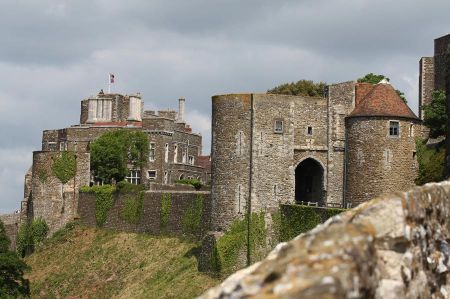 In the year 50 AD the Romans built two lighthouses on both sides of the river mouth that still existed at that time.
In the year 50 AD the Romans built two lighthouses on both sides of the river mouth that still existed at that time.
Nowadays, remains of it can be found on the Western Heights on the one hand and in the foundations of Dover Castle, on the other hand, where they were installed.
The Painted House is a former Roman administration building and one of the best preserved Roman buildings in Britain. The fortified port of the Roman fleet is right next to it. A Saxon coast fort was built over both in later centuries.
Medieval fortress of Dover
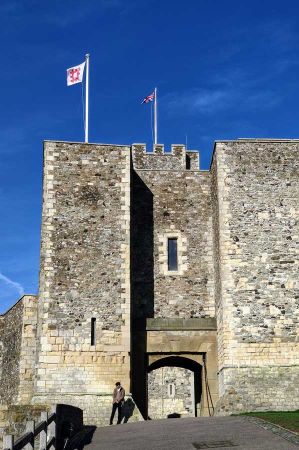 Archaeological research has shown that a new castle was built near the Saxon church of St. Mary de Castro, which later became today's Dover Castle. On the remains of the prehistoric ramparts, construction of the castle was started in 1168 by order of Henry II. In 1180 the Norman church, which now houses a museum, was built in the centre of the complex. In the 13th and 14th centuries, massive ring systems were added as additional security measures for reinforcement. The castle gradually began to take on its current form. The master was "Maurice the Engineer", who managed to build the castle in record time from 1168 to 1178. The inner and outer courtyards and the large rectangular shape, one of the last in this form ever built, also date from this period.
Archaeological research has shown that a new castle was built near the Saxon church of St. Mary de Castro, which later became today's Dover Castle. On the remains of the prehistoric ramparts, construction of the castle was started in 1168 by order of Henry II. In 1180 the Norman church, which now houses a museum, was built in the centre of the complex. In the 13th and 14th centuries, massive ring systems were added as additional security measures for reinforcement. The castle gradually began to take on its current form. The master was "Maurice the Engineer", who managed to build the castle in record time from 1168 to 1178. The inner and outer courtyards and the large rectangular shape, one of the last in this form ever built, also date from this period.
Massive conversions took place at the end of the 18th century during the Napoleonic Wars. Commanding engineer, William Twiss of southern England, completed the redesign of Dover Castle's outer bulwarks as part of his mission to strengthen the city's defence and added additional gun positions to the Horseshoe, Hudson's, East Arrow and East Demi Bastion on the east side, and constructed the Constable's Bastion to better protect the west side too.
Military technology is also changing Dover Castle
 Twiss also increased the lead at the north end of the castle, where he attached an elevated gun platform. By covering the roof of the tower and replacing it with a solid brick vault, he was able to position heavy artillery on it. Twiss also built the Canon’s Gateway to connect the castle’s defence with those of the city.
Twiss also increased the lead at the north end of the castle, where he attached an elevated gun platform. By covering the roof of the tower and replacing it with a solid brick vault, he was able to position heavy artillery on it. Twiss also built the Canon’s Gateway to connect the castle’s defence with those of the city.
After Dover became a garrison town, barracks and quarters and storage rooms had to be created for the additional troops and their equipment. Twiss and the Royal Engineers built tunnels 15 meters below the cliffs, and the first soldiers were quartered here in 1803. At the height of the Napoleonic Wars, the tunnels housed more than 2,000 men and are still the only underground barracks ever built in Britain.
With the outbreak of the Second World War in 1939, the tunnels were first converted into an air-raid shelter and later into a military command centre and military hospital. In May 1940, Admiral Bertram Ramsay directed the evacuation of French and British soldiers from Dunkirk from his command centre into tunnels.
From Roman Lighthouse to Fortress – The Eventful History of Dover Castle - more details
Dover: The Gateway to England
 If you've ever traveled to England by ferry, you're familiar with them – the white cliffs of Dover. But behind this impressive natural backdrop lies one of Europe's most historic fortresses: Dover Castle. And what's so surprising about it? It was built on the foundations of a Roman lighthouse, the so-called "Pharos," one of the oldest surviving Roman structures in Great Britain.
If you've ever traveled to England by ferry, you're familiar with them – the white cliffs of Dover. But behind this impressive natural backdrop lies one of Europe's most historic fortresses: Dover Castle. And what's so surprising about it? It was built on the foundations of a Roman lighthouse, the so-called "Pharos," one of the oldest surviving Roman structures in Great Britain.
Dover's Strategic Location
Dover lies at the narrowest point of the English Channel – only about 33 kilometers from France. It's no wonder that one fortress after another was built here over millennia.
A Place with Thousands of Years of History
Whether Romans, Normans, or British generals – everyone knew: whoever controls Dover protects England.
The story begins – The Roman lighthouse
Construction and function in ancient times
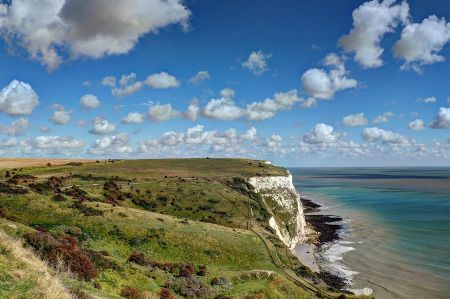 In the 1st century AD, the Romans built the Dover Lighthouse to safely navigate their fleet through the Channel. The structure was part of the military infrastructure monitoring the strait.
In the 1st century AD, the Romans built the Dover Lighthouse to safely navigate their fleet through the Channel. The structure was part of the military infrastructure monitoring the strait.
Part of the Roman defence line in Dover
Together with a garrison, the tower served as a base to protect the British coast against invaders and pirates.
Architecture of the lighthouse
Roman masonry and architectural style
The tower is made of Roman brickwork faced with limestone – stable, functional, and largely preserved to this day.
Special features of the Dover Lighthouse
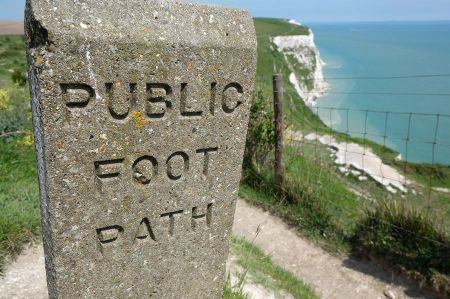 What's special: It is one of only two known Roman lighthouses north of the Alps – and the best-preserved of its kind in Europe!
What's special: It is one of only two known Roman lighthouses north of the Alps – and the best-preserved of its kind in Europe!
The role of the lighthouse in ancient times
Navigational aid for ships in the Channel
Fires were lit at night, and by day the tower served as a landmark – a clever solution, centuries before GPS.
Symbol of Roman presence in Britain
The lighthouse was more than just a maritime landmark – it symbolized Roman power and technological superiority.
Dover - Transition to the Middle Ages
Early Medieval Use
After the Romans withdrew, the tower was not abandoned but continued to serve as a landmark and protective structure.
Integration into the Medieval Fortress
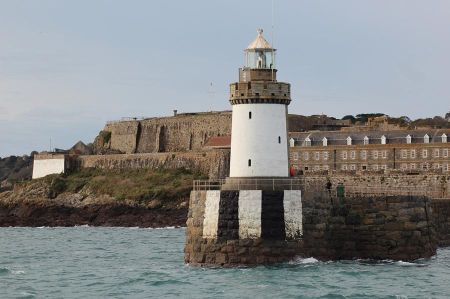 In the Middle Ages, the lighthouse was cleverly integrated into the new structure of Dover Castle – as part of the defense and ecclesiastical architecture.
In the Middle Ages, the lighthouse was cleverly integrated into the new structure of Dover Castle – as part of the defense and ecclesiastical architecture.
Dover Castle – The Expansion into a Fortress
Norman Conquest and Construction Plans
After the Norman invasion of 1066, the fortress was massively expanded. The aim was to secure England's most important seaport.
Henry II and the Great Reconstruction
In the 12th century, Henry II had the castle complex fundamentally modernized – with thick walls, towers, and secret passages.
The Roman Tower as Part of the Castle
Connection to St. Mary's Anglican Church
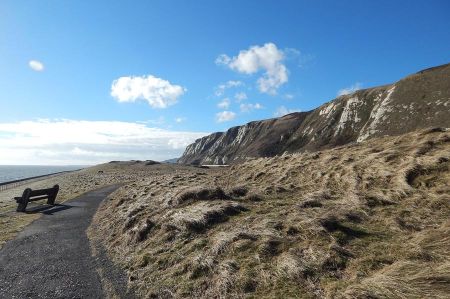 The lighthouse was used as the bell tower of the neighboring St. Mary-in-Castro Church – an exciting mix of antiquity and Christianity.
The lighthouse was used as the bell tower of the neighboring St. Mary-in-Castro Church – an exciting mix of antiquity and Christianity.
The Lighthouse as a Bell Tower
Thus, the former navigation point became a sacred focal point within the fortress.
Military Significance Through the Centuries
From the Crusades to World War II
Dover Castle was upgraded over the centuries – including underground bunkers during World War II.
Secret Tunnels and Defenses in Dover
During the Battle of Britain, the tunnels served as a command center – further evidence of the site's strategic importance.
Roman and Medieval Elements Compared
Construction and Technology
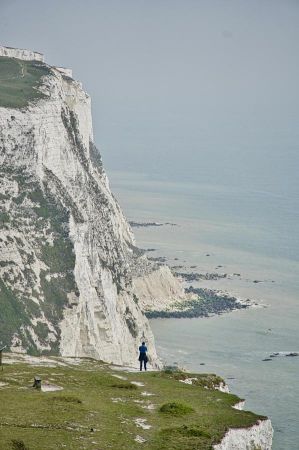 While the Romans valued functionality, the Normans combined defensive strength with prestige. You can still see both architectural styles today.
While the Romans valued functionality, the Normans combined defensive strength with prestige. You can still see both architectural styles today.
Continuity in Defense
From the lighthouse to the bunker – Dover has always been a bastion against invasion.
The Lighthouse Today – A Witness to Contemporary History
Conservation and Restorations
Thanks to careful maintenance, the Roman tower still stands proudly above the coast today – almost 2,000 years old and still impressive.
Guided Tours and Sightseeing Options
Visitors can marvel at the tower as part of the castle tour – a highlight for archaeology and history buffs.
Significance to British History in Dover
Symbol of Coastal Defence
 The lighthouse and Dover Castle represent England's millennia-long struggle for security and independence.
The lighthouse and Dover Castle represent England's millennia-long struggle for security and independence.
Historical and Cultural Heritage
Here, ancient, medieval, and modern times meet in one place – a lesson in living history.
Dover Castle as a Tourist Magnet
Highlights on the Castle Grounds
In addition to the lighthouse, the Norman castle, St. Mary's Church, tunnels, and panoramic views across the English Channel await.
The Roman tower as a photo hotspot
It is one of the most popular photo subjects – not only because of its history, but also because of its unique appearance.
Tips for Visiting Dover Castle
Opening Hours and Admission
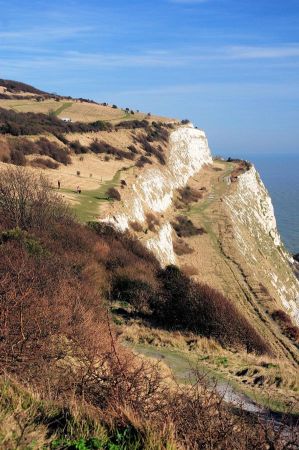 Dover Castle is open year-round (usually 10 a.m.–4 p.m.). Admission is around £25 for adults—but it's definitely worth it!
Dover Castle is open year-round (usually 10 a.m.–4 p.m.). Admission is around £25 for adults—but it's definitely worth it!
Best Time to Visit
Spring and autumn are ideal—pleasant weather and fewer tourists.
Conclusion—A Journey Through Time
Dover Castle and the Roman Lighthouse are like an open book of European history. Entering the castle takes you on a journey through time—from the Romans to the Normans to modern times. And the best part? The lighthouse isn't just a silent monument, but part of a living ensemble that reflects England's historic soul.
FAQs about the History of the Roman Lighthouse in Dover
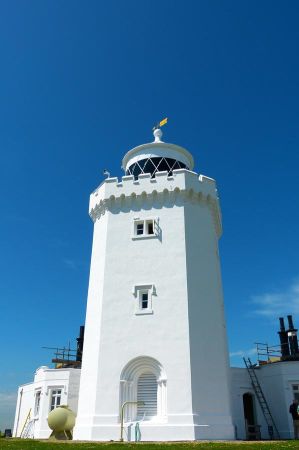 1. How old is Dover's Roman Lighthouse?
1. How old is Dover's Roman Lighthouse?
It dates back to the 1st century AD, making it almost 2,000 years old.
2. Can you visit the inside of the tower?
It is partially accessible and can be admired as part of a guided tour.
3. What role did the tower play in the Middle Ages?
It was used as a church bell tower and integrated into the castle complex.
4. What makes the Pharos unique in Dover?
It is one of the oldest and best-preserved Roman lighthouses north of the Alps.
5. What is the best way to reach Dover Castle?
By train from London (approx. 1 hour) or by car. From Dover Priory Station, it is a short walk to the castle.
Please read as well:
Symbolic and beautiful - The White Cliffs of Dover
Hiking in the Vienna Woods - our tour to Mostalm
